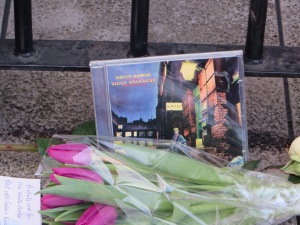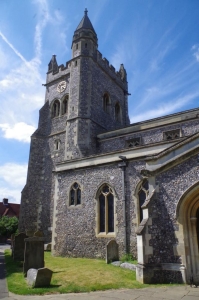This was originally going to be a short piece on roadside shrines. These are the impromptu response to remember road traffic victims. Grieving relatives and friends place flowers and messages so that casual passers-by would at least know the name of the deceased and that they were missed. The shrines were also originally intended to remind drivers to slow down and to be more careful with their driving. However, as a blog from the New York Times said, they can also be a distraction and may actually cause accidents rather than prevent them.
But a piece in my local freesheet in 2012 made me think. The Editor commented that roadside shrines had become ‘a tide of detritus left behind in the dead’s memory.’ He went onto say that ‘in times past different cultures had felt it essential to send the dead on their way with appropriate objects, if you were lucky they even killed a goat.’ He continued by saying that he had seen bottles of Smirnoff Ice, four cans of Stella, a packet of cigarettes, a West Ham shirt, a picture of a dead cat, and a meat pie and called them ‘ evidence of ‘a modern obsession with proving food for the dead.’ He questioned the object of leaving items that will attract thieves and vandals.
I have seen several roadside shrines and found them very touching but it’s sad when the flowers wilt, they become sodden by rain and then fade completely. The extra items that the Editor complained about may be the only way that the grief stricken can make the impersonal more personal and make sense of an inexplicable and sudden death. The shrines almost become a way of sharing the deceased with the world in that the casual observer knows that they liked a certain football team. They become a person again and not just a statistic.
But what finally prompted me to write this piece was the death of the rock icon, David Bowie on 10 January 2016 and the unofficial shrines that have been created in his memory and the items that fans left at them. I found out the news via the internet by logging onto Facebook and there it was. I was stunned and felt as if I’d been punched hard. After an hour of reading tributes I really felt that I wanted to do something. When Princess Diana died, I had been one of the many who had laid flowers at Kensington Palace in her memory. It was a public way of displaying sympathy for a woman who I genuinely felt had had a hard time. As Peter Watts says in his blog article on London Shrines:
‘What fascinated me also about all this was that it had a seditious, outlaw aspect. There was a lot of noise in the press about whether the Queen was treating Diana’s death with sufficient respect, and this huge impromptu shrine – by the people, against the establishment – was given the atmosphere of an almost revolutionary act. It was a fascinating combination – the privacy of remembrance, carried out on a larger scale with political implications.’
It was a once in a lifetime event.
According to social media and news sites people were already laying flowers at a mural of David in Brixton. I went out to buy flowers. However, Bowie had been a local lad to me in Beckenham in the early ‘70’s and the suburb also wanted to remember hm. At what had been the Three Tuns, now a Zizzi’s, pub in the High Street, where a wall plaque reminded us that he’d played there pre-Ziggy, a few people had already laid flowers. There were several people standing around looking completely stunned. I laid my daffodils in front of a large framed picture of the Bowie poster from the V & A show on Bowie and moved onto Brixton.

copyright Carole Tyrrell
I’d been aware of other rock star shrines such as Marc Bolan’s on Barnes Common and Jim Morrison’s grave in Paris but this time it was for one of my all time heroes.
The mural was in full colour and features Bowie in his Aladdin Sane period. On the wall next to it was a large colour ad for Iman’s, Bowie’s second wife’s cosmetics. When I arrived at around 10am there was already a media frenzy taking place. TV crews, people being interviewed, journalists with microphones looking for people to interview, professional photographers, and people of all ages. People had been laying flowers on their way to work and there were already more than a few. There were the casual passers-by who glanced over and moved on or took a photo on their phone and others who must have wondered what it was all about. A pavement evangelist informed us that Bowie had had no fear about dying. I wondered if that was true. But most of all there was an atmosphere of disbelief and shock.

copyright Carole Tyrrell
Since then the floral tributes at Zizzi’s have continued to grow and the overall feeling seemed to be one of fans thanking Bowie for being such a part of their lives and making such wonderful music. LP’s, props, and photos have also been left and so far none have been stolen. He was also commemorated at the Beckenham Croydon Road Recreation Ground bandstand which was where, in 1969, he had held a free festival and wrote the song, ‘Memories of a Free Festival’ to commemorate it. Candles had been lit here and a sympathetic council employee was keeping them lit.

copyright Carole Tyrrell
Fans were sharing their memories. At the bandstand someone had left a framed copy of the flyer for the free festival and it was interesting seeing the line-up for the first time. Photos, album covers, scribbled memories – to some they may well be detritus but they are personal recollections and I was fascinated by reading them. Parents were there with their grown up children who had probably grown up on Bowie’s music.

copyright Carole Tyrrell
The Brixton Shrine continued to be a focus. When I returned 2 days later to see it again and to visit Bowie’s birthplace at Stansfield Road, messages had been written on Iman’s advert and the two models had had Aladdin Sane flashes drawn on their faces. I added my little message. There was less of a media presence this time and more people adding to or looking at the flowers.
David Bowie was a pivotal figure for me. I remembered Space Oddity around the time of the moon landings and I’d picked up on Hunky Dory, the LP before he became really big. The early 70’s were such a grey time. The glittering dayglow Sixties were over. The Age of Aquarius had dimmed, the Beatles had split up and no one seemed to know what to do next. We wanted out own music, something different, harder and in 1972 when I saw Bowie singing Starman on Top of the Pops in 1972 I knew it had arrived. Glam rock as it came to be called may have ended up as bad make up jobs and Bacofoil l but it defined my generation. From then on I followed him as each successive LP became a major event. Bowie re-invented himself time and time again and along the way he introduced me to Andy Warhol, Iggy Pop, the Velvet Underground, William Burroughs, Kraftwerk and Jean Genet amongst others. And if he sometimes made an LP that wasn’t as great, well I simply that thought he would pull it off next time.
For many of us, David Bowie’s passing has been a huge event in our lives. We may not have met him but his music and his many personas made a deep impression. They don’t post rest in peace messages on the BT Tower to just anyone. It made me realise how powerful these collective mourning places can be as they were an important focus for us all. A way to pay our respects, to express our thanks at his music being such a part of our lives, and to acknowledge his existence. It was being with strangers, complete strangers, who we joined with for a brief moment, united by a common bond and then we became strangers again. A spontaneous event that marked the passing of an icon who had gone too soon.
The flowers will fade and be cleared away, the scribbled messages may also vanish and the mural, Zizzi’s, the bandstand will all go back to being milestones on Bowie’s journey. As with the roadside shrines, life has to go on.
My experience at the Bowie shrines was to think about my own future. He was a man who made his life count right up to the end. How long have I got? Is this what I want to be doing? Make the most of life it may be shorter than you think. And maybe that’s the oft used word, legacy, of them. A memento mori for a new generation – As I am now, so you will be. He didn’t waste his time on this earth and neither should you.
And maybe that’s what all shrines, roadside or otherwise do, remind you that life is fleeting and death is forever so make the most of it while you have it.
Sources:
‘Stella, fags, footie shirt, dead cat, meat pie.’ Andrew Parkes, Editor, Newshopper, 17/10/12
http://roomfordebate.blogs.nytimes.com/2009/07/12/should-roadside-memorials-be-banned/?_r=0
Further reading:
Rock http://greatwen.com/2016/01/21/shrines-of-london/Shrines Thomas H Green





























